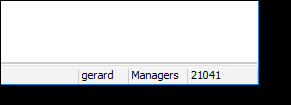- See Group Registry entry for details about assigning users to more than one group and for issue that may arise if a user is / is not logged in when a change is made to their Group Registry entry.
- See Multi-group Support: security profile extensions for details about how the EMu server security profiles provide support for multiple groups per user.
- See The Registry cache: Flushing and Enabling / Disabling for an explanation of when it may be necessary to flush / disable the Registry cache.
When a user is a member of more than one group, the Login box includes a drop list with the names of all available groups for the user:

Note: The list of groups that displays is determined by the combination of username + service. A user can have the same username on multiple services, and in each service may be a member of different groups.
A user can log in using one group, switch to another group while leaving existing modules open, perform operations in the new group and then switch back to the previous group, all without having to close any modules. A key feature of multi-group support is that it allows users to change roles without losing their current work position and then to return to that position at a later time.
By not closing open modules it is possible to have modules in different groups open at the same time. EMu ensures the correct group permissions are observed based on the group associated with the module.
Note:
- A user who is a member of more than one group can select the group name to use from the Login box when logging into EMu.
- It is possible to switch to another group at any time without logging out and back in again.
- When switching groups the user decides whether opened modules should remain open or whether they should be closed.
- Any new modules opened will use the group permissions assigned to the group that the user switched to.
EMu keeps track of the group selected when a user logs in to the system. This group is known as the active group.
Modules opened by clicking their button in the Command Centre belong to the active group.
If a module is opened from within another module, by selecting File>Modules>module, the module is associated with the same group as the module from which it was created. A module's group is displayed in the Status bar at the bottom right of the window. In this example the module was created from a module that was opened by a member of group Managers:

A module cannot change group. Once it is created and associated with a group, it will remain in that group.
It is possible to change the active group however. By doing so it is possible to create modules in different groups, thus allowing users to have multiple roles within the one EMu session.

